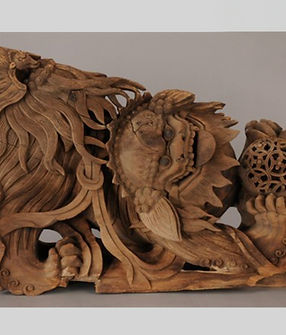A complex and exquisite visual Composition: The artistic leap of Huizhou Carving in the Qing Dynasty
After the Qing Dynasty began, the three carvings of Huizhou further developed from their Ming Dynasty foundations, exhibiting more delicate, three-dimensional, and highly decorative characteristics. The main features of Qing Dynasty carvings include the diversification and deepening of techniques.
-
In the Qing Dynasty, round sculptures and deep relief sculptures were widely used, which enhanced the expression of spatial layers, making the carved works more three-dimensional and visually striking.
-
The carvings integrated the composition of the Xin'an style of Painting. In terms of composition and layout, they absorbed the artistic techniques of the Xin'an style, such as the arrangement of foreground and background, the elegance of lines, and the creation of light and shadow, making the sculptures more visually appealing and narrative.
-
The carvings featured rich and exquisite themes, including pavilions, terraces, towers, flowers, birds, insects, fish, historical stories, and characters from operas, with intricate details, vivid content, and strong expressiveness.
-
Emphasizing hollowing out and decorative effects: Carving is often combined with hollowing out techniques to enhance perspective and ventilation effects, and also makes the overall carving more dynamic and light.
-
The visual beauty is prominent: The works pursue the equal importance of decoration and artistry, and even extensively use exquisite carvings on daily utensils, reflecting the increasing emphasis on art appreciation in the Qing society.
The carvings of Huizhou in the Qing Dynasty are often referred to as the ”peak of micro-carving art.“ It was no longer merely an accessory to architecture but became an independent artistic expression.
进入清代后,徽州三雕在明代基础上进一步发展,呈现出更加精细、立体和装饰性强的特点。清代雕刻的主要特征包括:
-
技法多样化与深化:清代大量采用圆雕和深浮雕,在表现空间层次上更为突出,使得雕刻作品更具立体感和视觉冲击力。
-
融合新安画派构图:在构图布局上吸收了新安画派的艺术手法,例如讲究远近景的安排、线条的飘逸、光影明暗的营造,使雕刻更具画面感与叙事性。
-
题材丰富精致:题材上出现了亭台楼阁、花鸟虫鱼、历史故事、戏曲人物等,细节繁复,内容生动,表现力更强。
-
注重镂空与装饰效果:雕刻常配合镂空技法,增强透视与通风效果,也让整体雕刻更为灵动轻盈。
-
视觉美感突出:作品追求装饰性和艺术性并重,甚至在日常生活器物上也大量使用精美雕刻,体现出清代社会对艺术欣赏的日益重视。
清代徽州雕刻常被称为“微雕艺术的巅峰”,它不再仅是建筑的附属,而成为独立的艺术表达。





